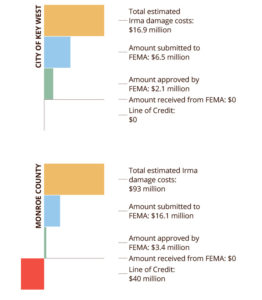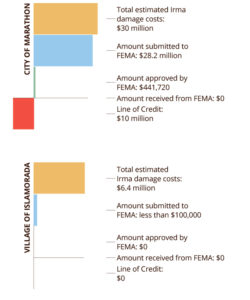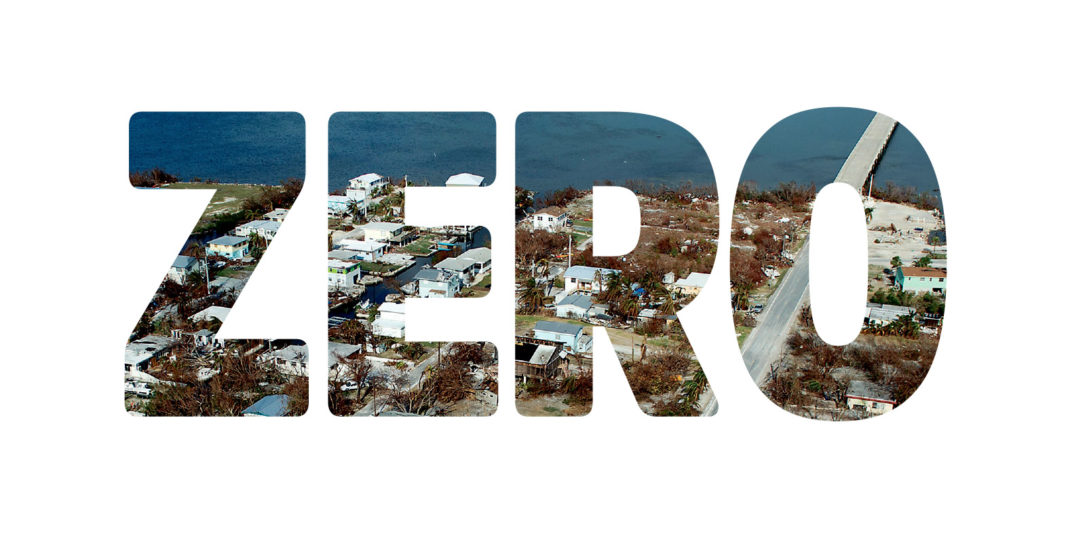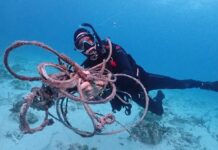By Sara Matthis & Gabriel Sanchez
Across the board, the governmental entities in Monroe County have yet to receive any federal funds associated with Hurricane Irma. In fact, the City of Marathon, Key West, Village of Islands and Monroe County have self-funded every bit of recovery that has happened since Sept. 10.
It is, admittedly, a very complicated process to submit a “project worksheet” or PW. And, yet, professionals started the job when Keys officials were still operating out of the Emergency Operations Center. From the beginning, Keys officials understood that every “i” had to be dotted and every “t” had to be crossed in order to apply successfully and receive the federal dollars administered by the Federal Emergency Management Agency, the so-called Public Assistance Grants.
“It’s cumbersome,” said Key West Finance Manager Mark Finigan. “The money is not flowing down. We have several ‘PW’s’ at the state level that don’t seem to be moving forward. Our federal FEMA representative, in place locally to support us, is unable to give us answers as to why this is not moving forward. I wish the state would assign a FEMA representative to the Keys, too.”
For example, the City of Marathon submitted one PW for citywide safety inspections in the amount of $441,720. It was sent to FEMA on Nov. 9, 2017. It has been “obligated” — meaning FEMA has approved the project — but has been stalled at the state level since then.
The costs associated with Hurricane Irma to local governments are staggering. Monroe County estimates it will cost $93 million. The Village of Islamorada says $6.4 million. Key West estimates $16.9 million and the City of Marathon estimates $30 million. Those are estimated costs, but it’s an important factor because in past storms, those round numbers were then used to expedite funds to the affected public agency. These are only estimated damages. For example, in the case of Monroe County that does not include future requests for mitigation or repairs to the airports.
“They used to expedite 50 percent of the claim, and then figure it out later,” said Monroe County Administrator Roman Gastesi on the advance of “upfront” money, “but they are not doing that any more.”
According to U.S. Rep. Carlos Curbelo’s office, Florida did not request expedited funding for emergency work which may have been requested by other states/territories.
Gastesi and other Monroe County officials traveled to Washington, D.C. last week seeking more recovery dollars, including for canal cleanup. He said he had the opportunity to meet with Director of Florida’s Division of Emergency Management Wes Maul. Maul told Gastesi that the Monroe County requests for funding had been assigned, but not “tasked” to an outside consultant, and would be shortly. Gastesi added that he hopes to see some activity this week.
“Listen, FEMA is overwhelmed. There were three hurricanes, and fires in California. It’s a complicated process, and ultra sensitive because there have been issues in the past,” said Gastesi.
According to the New Orleans Times-Picayune, the Hurricane Katrina Fraud Task Force, later renamed the Disaster Fraud Task Force, said it had prosecuted 1,439 people in half the country’s 94 federal judicial districts for illegal activity related to hurricanes Katrina, Rita and Wilma. Several entities reported that the amount of fraud could near $1 billion.
“What complicated things is that FEMA initiated a new reimbursement process and model on Sept. 17, 2017. So even the consultants and FEMA employees had to learn aspects of the new model,” said Islamorada Finance Director/ Deputy Village Manager Maria Basset.
Islamorada only recently received its final payment from the results of Hurricane Wilma-related expenses. Wilma hit the Keys in 2005.
The PW funding requests first land on the desk of a federal agent, a FEMA Program Delivery Manager. There is reportedly one in the Florida Keys who conducts weekly meeting with municipal and county stakeholders. After he deems it ready, it moves to the FEMA consolidated reporting center where it undergoes more checks such as environmental review. If it meets approval there, then it heads to the State Department of Emergency Management and the Public Grants division.
But Texas and Puerto Rico, for example, are faring differently after disasters there. There is wide disparity in how FEMA has obligated funds among states for events that happened both before Hurricane Irma, and after. For example, there is $633 million of obligated public assistance grant money for Hurricane Harvey in Texas. There is $1.3 billion for Puerto Rico and another $442 million for the Virgin Islands to recover from Hurricane Maria. So far, $26 million of public assistance grants have been obligated for the state of Florida to pay for Hurricane Irma.
Monroe County has obligated funds totaling $3.3 million out of a total $16 million submitted to FEMA in estimated damage. Every single dollar of that is accounted for by a professional adjustor, an expensive proposition.
The county, Marathon and Key West are using Adjustors International for help with FEMA forms. The Village of Islamorada has two adjustors from DMS Disaster Consultants and those services have already cost the village $400,000. Key West is including the administrative cost of these professionals as part of each PW. (For example, Key West submitted a reimbursement of $65,000 for emergency repairs to a footbridge; an additional $1,467 was requested to pay for the administrative costs.) Monroe County has a 26-page contract with Adjustors International. It is paying the Engagement Manager $275 per hour which includes lodging and other expenses. The Project Officer and Public Assistance Specialist are paid $205 and $175 hourly, respectively, including benefits.
Marathon has taken out a $10 million line of credit to cover Hurricane Irma recovery costs. Monroe County has a $40 million line of credit. Both Islamorada and Key West have been able to self-fund the projects thus far, but the lack of cash affects which types of projects it can tackle.
The Village of Islamorada had a big reserve leading up to Hurricane Irma — about $4.5 million in unassigned funds. The extra money has been used to cover Irma-related expense since last fall, but that money is gone now, said Bassett.
“If we don’t get reimbursement by the time we start on other projects, like Anne’s Beach, for example, then we could move on to borrowing money and taking advantage of the grants we have in place to go forward with the projects,” said Bassett.
The City of Key West is having a similar experience.
“For example, we’ve already spent $100,000 on repairs to Fire Station 3,” said Key West’s Finigan. “It has a partially collapsed roof, needed mold remediation and the generator inspected. That work has been done and paid out and we are putting together a PW to submit to FEMA.”
Key West has yet to tackle the estimated $1 million restoration of the basin seawall between Margaritaville Resort and Mallory Square connected by a footbridge. Finigan said engineers have been sent out to look at those needs.
“We can move some of our capital around, defer the capital plan so we can get that accomplished,” he said.
City of Marathon Chuck Lindsey said one of the most glaring needs in Marathon is to have Sombrero Beach restored. He said the city is not in a position to pay for the design, engineering and construction up front. “I can’t do that until I get an infusion of cash. I have to keep things rolling,” he said.
 City of Marathon
City of Marathon
Total estimated Irma damage costs: $30,000,000
Amount submitted to FEMA: $28,241,180
Amount approved by FEMA: $441,720
Amount received from FEMA: $0
Line of Credit: $10 million
City of Key West
Total estimated Irma damage costs: $16.9 million
Amount submitted to FEMA: $6.5 million
Amount approved by FEMA: $2.1 million
Amount received from FEMA: $0
Line of Credit: $0
 Village of Islamorada
Village of Islamorada
Total estimated Irma damage costs: $6.4 million
Amount submitted to FEMA: less than $100,000
Amount approved by FEMA: $0
Amount received from FEMA: $0
Line of Credit: $0
Monroe County
Total estimated Irma damage costs: $93 million
Amount submitted to FEMA: $16,095,259
Amount approved by FEMA: $3,382,650
Amount received from FEMA: $0
Line of Credit: $40 million
























